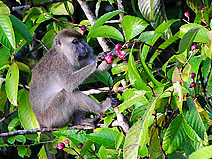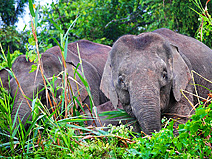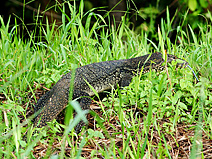News from Borneo: Vol. 1
In the Malaysian state of Sabah of the island of Borneo, where the activities of the ITOCHU Group Forest for Orang-utans take place, sixteen Company employees and employees of Group companies participated in a tree-planting tour.
We introduce here the fascinating natural environment the participants encountered and their thoughts about the tour.
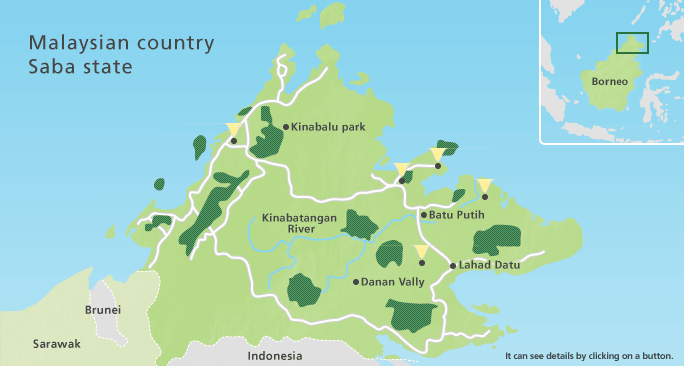
North Ulu Segama
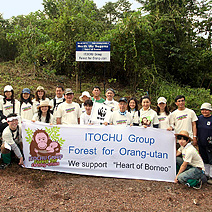
This is the reforestation area for this project. We are supporting 967 hectares (207 times the size of the Tokyo Dome) for forest regeneration.
Comments from Participants
Finally, the day to begin planting had arrived. Dressed in matching T-shirts and wearing socks that stop leech bites, the tour members headed off on their bumpy ride to the planting site.
The tree planting began following a demonstration of planting techniques by WWF.
It wasn’t long before the combination of high temperatures and humidity and having to work in long sleeves and trousers had everyone covered in mud and dripping with sweat.
Still, by the end of our commemorative first tree planting session, the sense of accomplishment and relief felt by all those present was clear to see.
Sukau
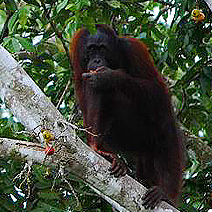
We can see Borneo elephants and proboscis monkeys and a lot of other wildlife in places where jungle tours are popular on the Kinabatangan River.
Comments from Participants
“Is that an orang-utan?!” a voice suddenly rang out in the car as we were on the move after the tree-planting. We quickly turned to look in the same direction and spotted a wild orang-utan. We were only ten or so minutes away from the tree-planting site. We were really lucky to encounter one of the orang-utans that this program is trying to protect in such a place.
Sandakan
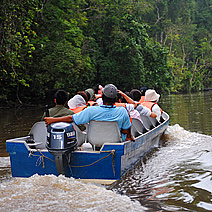
Sandakan is the second city after Kota Kinabalu. It flourished as trading post and as the heart of British North Borneo until 1947 when the capital was moved to Kota Kinabalu.
Comments from Participants
As we set out on the morning’s river tour at sunrise, we still felt excited by the deep emotions of the lucky encounter with a group of pygmy elephants on the river tour the day before. After breakfast, we transferred to Sandakan by a different boat. We felt very satisfied as we saw more wildlife than expected including a two-meter crocodile and an Orang-utan parent and child. The river tour made us realize that saving this abundant natural environment for posterity is also a service to humanity.
Sepilok
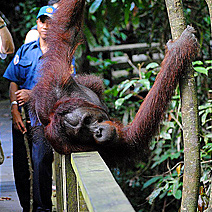
The Orang-utan Rehabilitation Centre, which returns orang-utans on the verge of extinction to the wild, is located here.
Comments from Participants
We visited the rehabilitation center, which is about a 30 minute drive from Sandakan port. More than 4,500 hectares of virgin forest has been designated as nature preserve area, and in one part of the area, there is a facility for training protected orang-utan infants to return to the wild. I thought it was charming to see them seated quietly like human children before the keeper who gave them their food.
Kota Kinabalu
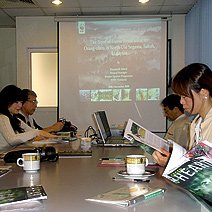
The gateway to tours of Borneo, Kota Kinabalu the city is also a growing commercial center with a population of approximately 300,000.
Comments from Participants
At the local WWF office, we were briefed on the reforestation project.
We learned how regenerating the forest, rescuing the invaluable wildlife inhabiting the island of Borneo from extinction, and protecting biodiversity are ultimately linked to the protection of all wildlife on the planet, which increased our motivation for the tree-planting on the following day.
Tree-Planting Tour
Itinerary
Day1 Narita - Kota Kinabalu(Borneo)
Filled with anticipation and excitement for the coming tour, participants from across Japan gathered for their flight at Tokyo Narita International Airport. One member got stuck in traffic but somehow managed to make it to the check-in counter five minutes before the gate closed. In the end, the flight left on its five-hour journey to Kota Kinabalu with every member accounted for. At the airport in Kota Kinabalu, people in traditional ethnic dress were everywhere! It was here, amid the excitement of arriving in Southeast Asia, that our first tree-planting tour would get under way. After dinner at the hotel, we visited the many street vendors set up in front of the hotel. They seemed to have everything—local grilled chicken skewers...grilled fish...noodles. The flavors and tastes available were a real snapshot of the local cuisine.
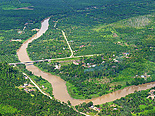
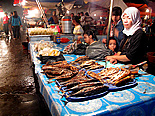
Day2 Kota Kinabalu(WWF Kota Kinabalu Office) - Lahad Datu
At the local WWF office, we were briefed on the reforestation project in the state of Sabah on the island of Borneo. Do to Sabah losing 30% of its forest from 1950 to 2000, it was important for us to learn about the several stages of the tree-planting process until the tree is fully grown and that orang-utans and other wildlife have lost much of their natural habitat. Over the five years following the tour, we intend to transform 967 hectares of the area into a new forest home for orang-utans! Tomorrow we can finally start the work.
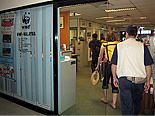
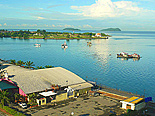
Day3 Lahad Datu - Ulu Segama(planting site) - Sukau
At the reforestation area, we received a lot of kind support from Ms. Yumiko Kawamura of WWF Japan, WWF Malaysia staff and contractors, and officials from the Sabah Forestry Department.
We were very happy not only because we felt accepted as colleagues working together on the tree-planting project and but also no one involved on the Malaysian side took the attitude that they let us plant trees only which made Itochu feel more like contributor. I think choosing WWF as a partner for the tree-planting project was definitely the right thing to do. I feel grateful to WWF for giving us this invaluable experience.
Next we moved on to Sukau, the second stop on the tour. The group was quickly divided into two boats to observe wildlife during the trip along the Kinabatangan River. The first creature we encountered was a spectacular bird called the oriental pale-billed hornbill. Soon after, we were greeted by both a pig-tailed monkey and a proboscis monkey. Though while the species certainly differ, Japan has its own wild birds and monkeys, therefore those present seemed a little let down until the boats suddenly made a sharp U-turn. As we looked to see what had happened, there in front of us was a Borneo pygmy elephant on the riverbank enjoying a meal.
The mood quickly filled with excitement, and growing expectation that we might even see crocodiles.
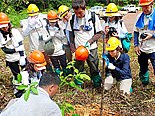
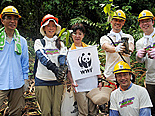
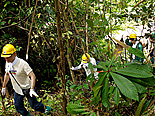
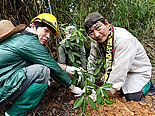
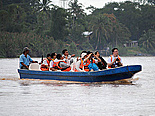
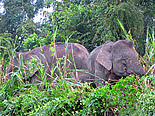
Day4 Sukau - Sandakan – Sepilok (Orang-utan Rehabilitation Centre)
On the ship carrying us to Sandakan, we soon sighted both the long-awaited crocodiles and orang-utans one right after the other.
Earlier, we had been told that orang-utans love fruit, and that they typically eat the fruit they find growing in tall trees as they move from branch to branch. It was also explained to us that the fact that wild orang-utans and people see each other at all is proof of the loss of their habitat. Watching wild orang-utans devour fruit in low trees, at a distance almost close enough to touch, really impressed upon on us the deeper significance of the activity we are involved in.
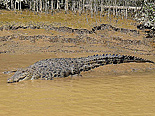
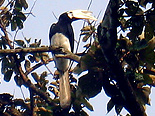
Day5 Sepilok - Kota Kinabalu - Narita
We visited the Sepilok Orang-utan Rehabilitation Centre, which is managed by the Sabah Wildlife Department. Here, orphaned orang-utans who have lost their parents because of forest development are protected, and after training in the forests at the facility, they are returned to the wild. We learned that the number of protected orang-utans increases in step with development, and we felt strongly that we should be more aware of our choices even when we make casual purchases.
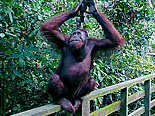
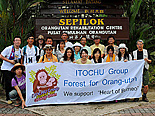

Operations Office, WWF Japan
Recreating a Forest of Biodiversity
As volunteers looked on, the first of many saplings was carefully placed in the soil. This moment marked the start of a new stage for the ITOCHU Group and its reforestation project. One day, the 967- hectare reforestation site will again be transformed into a lush forest home for orang-utans. Planting trees on a slope to conform to the natural contour of the terrain is harder work than one can imagine under the relentless tropical sun. Despite this challenge, thanks to cooperative work, we managed to properly plant some 50 saplings on that day.
In actuality, a great deal of work was necessary to make the day of planting possible, including surveys of local flora and fauna ecosystems, and contract negotiations with local stakeholders. Reforestation has many different levels, but the aim of WWF is high-quality reforestation projects that leverage the latest science, and cooperation with local stakeholders, to return forests to their natural state.
Beyond the experience of tree planting, the tour was filled with glimpses of Borneo’s natural riches, including encounters with wild orang-utans and a large herd of Borneo elephants. I am also deeply grateful for the chance to get to know so many outstanding employees from the ITOCHU Group through the tour, and the opportunity to share in the wonder of nature with them. I sincerely hope that in the future, this tour will allow many more ITOCHU employees to experience the beauty of nature for themselves.
Animals in Borneo that We Encountered on the Tour
